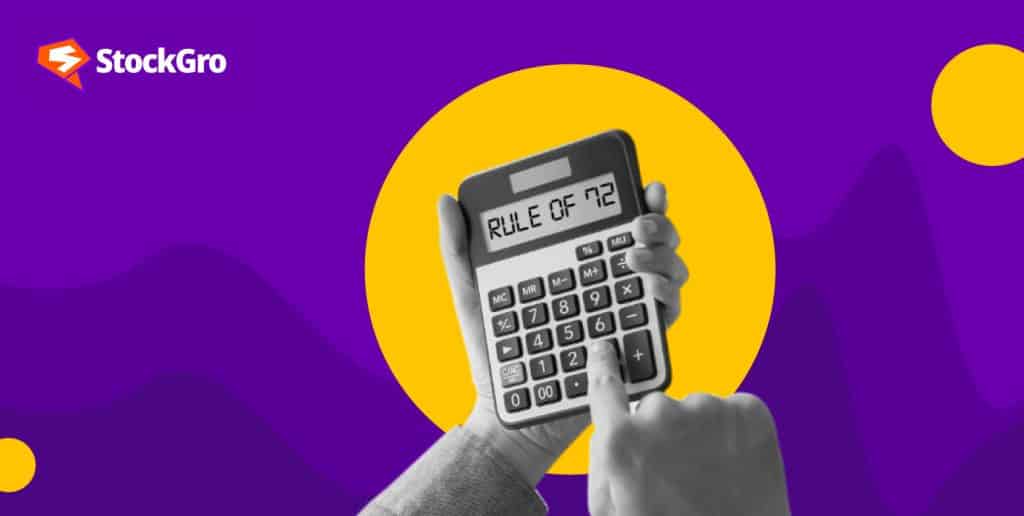
The main reason for investing our money is growth. As the time passes, the value of money decreases due to inflation. What our money can buy today, the same money cannot buy it in the future. This phenomenon is known as the ‘Time Value of Money’. To combat this time value of money, we invest our money and desire that it grows with the times.
Rule of 72 is a magic wand to find how much time is required for the money to double. Read more to know the formula, application, and significance of the rule of 72.
What is Rule of 72?
The famously known ‘Rule of 72’ is a beginner-friendly formula to calculate the period for money to double. It is an approximation method with a compounding rate for calculating the years needed to grow 2x.
So why specifically the number ‘72’?
The divisibility of 72 is the secret behind using this number especially. The number is divisible with the majority of numbers such as 1,2,3,4,6,8.9.12
Formula, prerequisites, and applications
The roots for the ‘rule of 72’ formula, are found in the book ‘Summa de arithmetica’ written by a mathematical genius Luca Pacioli. Moreover, the formula is derived from the complex calculation using logarithm and the compound interest formula:
Future Value = Present Value *(1+R)T
R is the compounding rate, and T refers to the time. So our investment would double with the following formula:
2=1*(1+ R)T
2=(1+R)T
However, this becomes a complex calculation for regular use. So, the equation was later simplified to the ‘Rule of 72’. This formula gives an approximate number of years. So, the formula is as follows:
T 72/R
Here, T = Number of years to DOUBLE the money
R = Rate of interest offered (%)
(Note: The rate % used here is as per the given form and not in simplified percentage form).
Let us understand with a rule of 72 example:
I invest in a fixed deposit (FD) with an interest rate of 6%. The number of years for my investment to double can be calculated as follows:
T72/6
T 12
Thus, in 12 years the amount in FD would double.
The most necessary prerequisite for this formula is that the rate involved should be the compound interest rate. The reason for this prerequisite is that compound interest appropriately accommodates the concept of the time value of money. The wide popularity of the rule of 72 compounding also indicates that in recent years the interest on almost all the instruments is calculated by compounding interest rates.
Read more on compounding: Compounding or annualised.
The rule of 72 can be further applied in different ways where the rate is in terms of compounding and not simple terms. Other than the rule of 72 investing, it can also be applied in estimating the number of years needed to double the:
- The loan amount
- The Gross Domestic Product (GDP)
- Population
- Other macroeconomic numbers, etc.
Also read: Time value of money: calculation and formula
Does it remain the same for all the rates?
The ‘Rule of 72 ’ is the nearest approximation for the period and not the exact measure Due to similar reasons, it cannot provide the nearest time needed to double all the rates. Studies indicate that adjustments are made to accommodate higher and lower rates.
The Rule of 72 is the best suitable for the rates from 6% to 10%. For other rates, adjustment is done by considering the threshold of 8%. When there is a 3% point rise or decline in the 8% mark, the number ‘72’ is treated with 1. The following table indicates this approximate variation:
| Rate | Rate*Time | No. of years to Double (Time) [approx.] |
| 1% | 68 | 68 |
| 2% | 68 | 34 |
| 3% | 69 | 23 |
| 4% | 69 | 17.2 |
| 5% | 69 | 13.2 |
| 6% | 72 | 12 |
| 7% | 72 | 10.2 |
| 8% | 72 | 9 |
| 9% | 72 | 8 |
| 10% | 72 | 7.2 |
| 11% | 73 | 6.6 |
| 12% | 73 | 6.0 |
| 13% | 73 | 5.6 |
| 14% | 74 | 5.2 |
| 15% | 74 | 4.9 |
Read more: The concept of rate of return is the key to making investments. Know how.
Bottomline
The ‘Rule of 72’ is one of the best tools for beginners to assess their investment. The power of compounding is realised when we use this tool. Also, its wide applicability helps in understanding the macroeconomic data. Moreover, by taking note of the basic variations as per the table given in the article, one can easily assess the approximate time needed for money to double.
FAQ
Q1. What is Rule of 72 in simple terms?
The number of years to double the money is calculated by the famous ‘Rule of 72’. The formula is used by dividing 72 by the compounding rate. This answer is an approximate calculation and works best for interest rates from 6% to 10%. For example: an investment made with 8% compound interest will double in 9 years (72/8).
Q2. Is Rule of 72 still valid?
The rule of 72 is a beginner-friendly approximation of the years needed to double the money. This rule was common for all the rates, but gradually some variations were made for the approximation. These variations made it more suitable and valid for accounting for any number for the compounding rate.
Q3. Can you explain Rule of 72 and Rule of 69?
The rule of 72 explains the approximate number of years needed to double the money at prescribed compounding rates from 6% to 10%. While the rule of 69 functions similarly to obtain the number of years to double the money, the range of its compounding rate is from 3% to 5%. As per the Rule of 72, you can double the money with a rate of 4% in 18 years (72/4), but as per the Rule of 69, the money would double in 17.25 years. Thus, the nearest approximated period is obtained.
Q4. Why is the Rule of 72 accurate?
The divisibility of 72 with almost all the numbers makes it an appropriate choice for approximation. Rule of 72 (using this divisibility) determines the years money needs to double with a compounding rate. Moreover, the variations of the rule of 72 made over time provide the nearest approximation by making the base ‘rule of 72’ more accurate.

